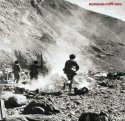darth sidious said:
plz provide evidance of huge chinese casulties
They are unavailable outside the Great Wall.
Reference to the following may be made:
----------------------------
The China-India Border War
CSC 1984
SUBJECT AREA: Warfighting
ABSTRACT
Author: CALVIN, James Barnard, Lieutenant Commander,U. S. Navy
Title: THE CHINA - INDIA BORDER WAR (1962)
Publisher: Marine Corps Command and Staff College
Date: April 1984
The object of this paper is to present an overview of
the 1962 China-India Border War. The paper chronologically
examines the 19th and 20th Century roots of disputed border
areas between China and Indian the increase in tensions and
conflicts in the late 1950s, the skirmishes along the China-
India border, the October-November 1962 hostilities, and the
ceasefire.
---------------------
The following is a quotation from the research paper:
"Yet, an important example of the limited Chinese information available has been
this author's inability to obtain Chinese casualty figures
for the Border War."
The entire paper is available here:
Some excerpts:
India's casualties for the Border War were finally reported as follows:
Killed 1,383
Captured 3,968
Missing 1,696
India released no figures for Wounded, but casualties were
high.
China released no casualty figures.
The paper details Indian companies being attacked by Chinese brigades. It also highlights that the Chinese had much superior numerical and machine-gun fire as compared to India.
Here is another excerpt:
An Indian patrol of fifty Rajputs had moved to Yumtso La
without incident on the evening of October 9th. At daybreak
on October 10th, they began to move toward the Yumtso La
bridges.
Outnumbering the Indians by about 20:1, a full bat-
talion of Chinese emerged from their positions and quickly
moved down the ridge, to form for attack. The Indian positions
came under fire from heavy mortars. The Indians were able to
hold off the first Chinese assault; the Chinese were apparently
unaware of the Indian positions covering Tseng Jong village
from the flank, and enfilade fire caused heavy Chinese
casualties. The Indian commander at Tseng Jong asked for
covering fire while he withdrew from what he felt was a hope-
less position; but the covering fires were refused. As the
Chinese pressed their attack,
the Indian force of fifty was
ordered to disengage and retreat to the river; engagement at
Tseng Jong would have meant disaster for the Indians. The
Chinese allowed them to withdraw, and held their fire as the
survivors crossed the bridge to the south.
Chinese casualties
were 33 killed or wounded. Indian casualties were seven
killed, seven missing, and eleven wounded--50% casualties.
The Chinese buried the Indian dead with full military honors,
in plain view of the retreating Indian comrades withdrawing
south of the river.








